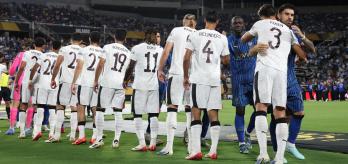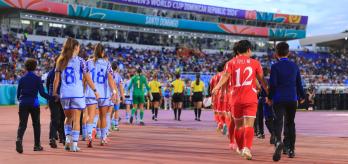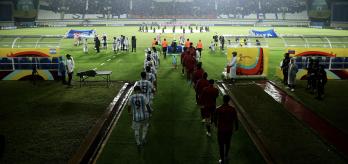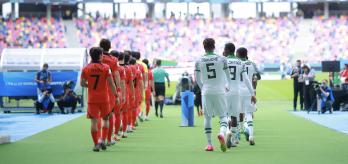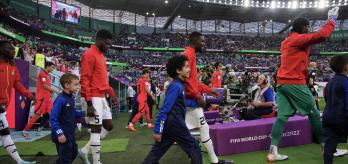Key take-aways
-
The relative age effect was present once more at the FIFA U-20 World Cup in Chile, with 42.1% of participating players born between January and March compared to 13.1% between October and December. This increased from 36.7% and 16.7% on the tournament’s previous edition.
-
Over three-quarters of players (77.4%) play for first-division clubs, ranging from full participation for Argentina and Mexico to just one-third for Cuba (33.3%).
-
Most players (74.2%) play for clubs within their own national associations, slightly down from 79.8% in 2023, suggesting a growing globalisation of young talent.
Introduction
Both FIFA High Performance and the CIES Football Observatory research group analysed the birth dates and the height of the 504 players selected, their teams and leagues of employment, as well as their possible selections in younger age categories (national teams from U-16 to U-19). Furthermore, this study also compares the results obtained with those of the previous FIFA U-20 World Cup, which took place in Argentina in 2023.
The 24 qualified associations represent all confederations, with a maximum of five for UEFA and CONMEBOL and a minimum of two for the OFC, with the AFC and CAF represented by four teams. One association is participating in a U20 World Cup final tournament for the first time, New Caledonia, while five participating nations have won the trophy previously, including Argentina (six times), Brazil (five times), France, England, and Ukraine (once).
Players’ birth dates
Analysing the birth dates of the selected players allows us to understand their distribution by year and month of birth. In terms of year of birth, although most of the players were logically born in 2005, a significant proportion (43.1%) were born in 2006 or later. In 2023, the figures were comparable, with rates of 57.9% (2003) and 42.1% (2004 and later). Eight selected players were born in 2008, and the two youngest were born in 2009 (Ebenezer Harcourt and Mustapha Kamaldeen, both in the Nigerian team).
The analysis by month of birth makes it possible to test the existence of a Relative Age Effect (RAE). This concept refers to the usual overrepresentation of players born in the months closest to the limit chosen to define an age category, in this case, January. These players generally have a competitive advantage due to their more advanced age and physical development compared to players born later in the year. Across the sample, this effect is clearly confirmed, with 42.1% of players born in the first quarter of a year, compared to 23.3% in the second, 21.4% in the third, and 13.3% in the last quarter. Compared to FIFA U-20 World Cup 2023, the RAE has intensified, where 36.7% were born in the first quarter and 16.7% in the last quarter.
The RAE exists for both players born in 2005 (41.1% born in the first quarter) and those born in 2006 (43.1% born in the first quarter). Therefore, the advantage of being born early in a year extends beyond the first year of eligibility. In this specific case, in absolute terms, there are even more players born in the first quarter of 2006 (62 selected) than in the last quarter of 2005 (38 selected). This result can be explained by the fact that footballers born between October and December are less likely to be selected by the best training clubs and national youth teams, resulting in limited opportunities to train, play and develop at the highest levels. In comparison, this benefits relatively older players, particularly those born between January and March, who have greater access to training and competition, and subsequently enhanced developmental outcomes.
Compared to the 2023 edition, the RAE has intensified. A higher percentage of players were born in the first quarter, while the opposite is true of the fourth. More players were born in the first quarter of 2005 (41.1%) than in 2003 (31.8%) for the previous U-20 World Cup in Argentina.
The RAE exists in all confederations, albeit at varying levels. The highest percentage of players born in the first quarter was recorded in UEFA (51.4%), followed by CONMEBOL (46.7%), AFC (45.2%), Concacaf (38.1%), CAF (31.0%), and OFC (31%). When compared to 2023, UEFA associations continued to have a high percentage of players born in the first quarter. However, for other confederations, the differences depend heavily on the teams that qualify for each edition. The data per association can be found in Figure 15 in the Annex.
The RAE was observed for all positions, which once again demonstrates the structural importance of this phenomenon in the training career of young football players. The most notable difference was between defenders (44% in the first quarter) and midfielders (39.3% in the first quarter), which may be explained by the physical and technical profiles of these positions.
Height of the players
The average height of the 504 players selected for FIFA U-20 World Cup 2025 was 179.7 centimetres (cm). The shortest player was Mexico’s defensive midfielder, Diego Sánchez, who measures 1.55 metres. At the other end of the scale, Ukraine striker Oleksandr Pishchur (2.04 m) was one of three players with a height of 2 metres or more. Players from European associations were the tallest, with an average height of over 1.80 metres. In contrast, African associations were distinguished by their shorter players.
Clubs and leagues of employment
All players who participated in the FIFA U-20 World Cup compete for a club, often being integrated into multiple teams. For the purposes of this analysis, players were assigned to the national level of the club’s best team. For example, the young Spaniard Andrés Cuenca, who plays for Barca Athlètic, is listed as a member of FC Barcelona and is considered to belong to a Spanish first-division club. In addition, players on loan were identified as belonging to the club to which they have been loaned.
The 504 players selected for the FIFA U-20 World Cup competed in 331 different clubs. The distribution of players between these different clubs varied significantly depending on the association. On the one hand, Nigerian footballers were employed by 19 different clubs, indicating a very wide dispersion among those sports entities. In contrast, players from South Africa and New Zealand were distributed across a smaller number of clubs (9). In New Zealand, it is important to note the role of the two clubs affiliated with the Australian A-League — Wellington Phoenix (9 players) and Auckland City FC (5) employ more than 60% of the U-20 national team.
In total, 77.4% of the players who were selected for the FIFA U-20 World Cup play for a first-division club. As we had already observed in 2023, this percentage was particularly high in CONMEBOL (92.4%), where the top clubs do not hesitate to integrate the best young talent into their ranks. The relatively low percentage measured in UEFA (68.6%) can be explained by the numerous loans made by Italian and Norwegian clubs to lower divisions.
All the players selected by Argentina and Mexico play for first-division clubs. This reflects the emphasis on young, local talent in these leagues, where the clubs’ business models are heavily focused on developing and transferring them to wealthier teams. At the other end of the spectrum, the Cuban context is unique in that only seven players are in a first-division club, with six playing in Cuba and one in Italy. Eight players transferred recently to the Costa Rican second division. To improve the quality of national football, the Cuban government now permits players to move abroad while retaining their eligibility for selection to the national team. This measure, combined with geographical proximity, creates an economic opportunity for Costa Rican second division clubs and young Cuban players.
Like in 2023, the relatively low proportion of Japan and Korea Republic’s players in the top divisions is likely linked to two main factors: the importance of high schools with no affiliation to professional clubs in the training of players, and the reluctance of top-flight clubs to give young players a chance, as the start in professional football in these countries generally occurs later than elsewhere.
With regard to the proportion of footballers playing for clubs in the association represented, three-quarters of FIFA World Cup U-20 2025 participants fell into this category. This figure is slightly lower than in 2023, indicating a trend towards the internationalisation of club squads. The highest percentage was measured at the AFC level (86.9%), while the lowest was measured among CAF and Concacaf selections (61.9%). This may be explained by the tendency of African players to go abroad at a young age and by the selection of footballers born outside their country of origin. Morocco notably follows the latter strategy, selecting young players from the Moroccan diaspora living in European countries, particularly the Netherlands and Belgium.
As previously discussed, Cuban players are taking advantage of the country’s recent openness to emigrate to other leagues and gain professional experience. In Europe, the emigration of young players trained in Ukraine is connected to the ongoing conflict with Russia. In contrast, the entire Saudi Arabia squad that was selected play in their own country. This is indicative of the efforts made by local training programmes, but it also underscores that young Saudis are not exporting their talent to other countries, despite having limited playing time in the national leagues.
The top five associations with the most players playing abroad can be found in Figure 15.1 in the Annex.
Participation in previous youth national teams’ age categories
The transition of players between the different age categories of the youth national teams is also an important topic. In many associations, where training at club and academy level is not yet at the level of the other countries where it is well developed, the national youth team pathway is potentially of particular importance in allowing the best talents to develop their full potential.
It is important to recognise that statistics on international youth team matches are subject to several biases. Firstly, the existence of official competitions for young age categories varies greatly depending on the confederation. In Europe, for example, players can be selected for multiple youth teams that frequently participate in competitions. Conversely, opportunities are more limited in other parts of the world. Secondly, there is a lack of reliable data for some associations, which minimises the number of players involved in youth teams. Nevertheless, despite these limitations, the results provide some interesting information.
58.5% of players selected for the FIFA U-20 World Cup 2025 had previous experience with other youth national teams, but figures varied considerably between confederations. The AFC and UEFA had values above 80%. Meanwhile, CAF and CONMEBOL barely reached a third of the total number of players. These differences can largely be explained by structural effects, such as more youth competitions for Asian and European players, and fewer for CAF and CONMEBOL players, as well as a lack of data for some youth national team matches.
The United States recorded the highest percentage, closely followed by European and Asian teams. In the OFC, New Zealand draws on the same pool of players that participated in the 2024 U19 OFC Championship, which is open to the U20 category. France’s position may be surprising, with only 61.9% of players having youth international experience, which may be due to clubs not releasing their players for the tournament, potentially impacting their transition rates and player development opportunities at national team level.
More than half of the players selected by Spain, Norway, Italy, and Argentina were previously selected by U-16 or U-17 teams. These associations rely on a pool of players who have been monitored for several years and have gained significant international experience. Competing in major international competitions such as the FIFA U-17 World Cup enables nations like New Caledonia to provide their players with genuine international experience.
Conclusion
The article highlights the existence of a RAE. In fact, compared to Argentina 2023, the RAE increased. Specifically, players born between January and March were overrepresented (42.1% of all players), while those born in the last quarter of the year were underrepresented (13.3% of all players), whereas they were respectively 36.7% and 16.7% in 2023. This effect is marked particularly within the UEFA selections, with 51.4% of players being born between January and March and only 8.6% between October and December. Following each edition, this finding reaffirms the importance of the RAE: the selection process must take into account the players’ month of birth and biological age.
The players who took part in the FIFA U-20 World Cup are employed by 331 different clubs, which are located all around the world. As in 2023, more than three-quarters play for first-division clubs (77.4%), with percentages ranging from 100% for Argentina and Mexico to just one-third for Cuba. These discrepancies reflect the different roles played by elite clubs in the training of footballers — a very important role in South America and a much less important one in Africa.
Most of the players that were selected play for a club within the national association represented (74.2%). There was a decrease since 2023 (79.8%), which appears to suggest a growing internationalisation of the young talents market. Footballers playing abroad either grew up there, as in the case of many of the players selected by Morocco, or went abroad because of international recruitment, as in the case of Cuban midfielder Michael Camejo, who transferred from FC La Habana (CUB) to PFA Antioquia (CRC) in January 2025.
Lastly, it is notable that 58.5% of players selected for the FIFA U-20 World Cup had previous experience with other youth national teams. The AFC and UEFA had values in excess of 80%. Meanwhile, CAF and CONMEBOL only reached a third of the total number of players.











